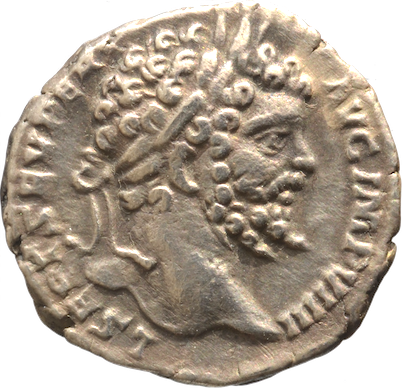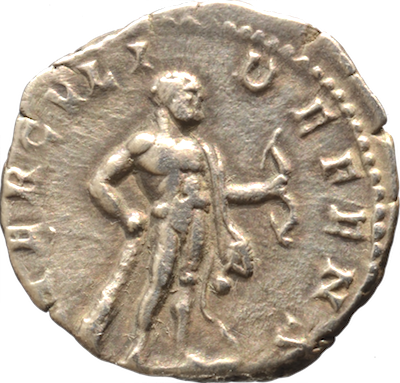mgcoins database 
Rome AD 197 AR denarius 2.31 g 1.63 cm 1.64 cm 5h
obverse: hd Septimius Severus r laureate L SEPT SEV PERT AVG IMP VIIII
reverse: Hercules stg r resting on club and holding bow, lion's skin over l arm HERCVLI DEFENS
Sear RCV II 6284, RSC 212
Munthandel G. Henzen list 242 (August 2012) no. 526
Septimius Severus 145 193-211
Under Divine Auspices: Divine Ideology and the Visualisation of Imperial ...
Clare Rowan
Hercules Defensor and the war against Albinus
1t was apparent that Severus intended to break with Albinus, who was stationed in Lugdunum.
Caracalla was made Caesar, indicating that Severus biological son, and not Albinus, was to inherit the throne.
The coin with HERCVLI DEFENS was introduced n AD 196/7, around the time Severus broke with Albinus.
The epithet represents Hercules as a defender or protector.
Hercules was simultaneously a patron deity of Lepcis Magna and closely connected with the West of the empire.
The coin had a specific context: the war against Albinus.
Hercules epithet defensor was likely connected to the propaganda that formed part of Severus campaign.
Defensor highlights the idea that Albinus was a menace, and the epithet was apt for the god who
would guide Severus to victory.
Leisure, Pleasure and Healing: Spa Culture and Medicine in Ancient Eastern ...
Estee Dvorjetski
There is evidence for an association between Hadrian and symbols of healing on coins and reliefs.
There are numerous Roman coins depicting healing deities such as Aesculapius, Hygieia, Apollo
and Serapis. These may have been representations of thanks by the Emperor for recovery from
a particular illness or, in some cases, a supplication to the gods for a cure from illness.
An interesting depiction is that of Heracles. According to a Dictionary of Ancient Roman Coins,
Heracles was given the surname of Alexicacus (one who drives away illness), a name also given to Apollo.
|
|